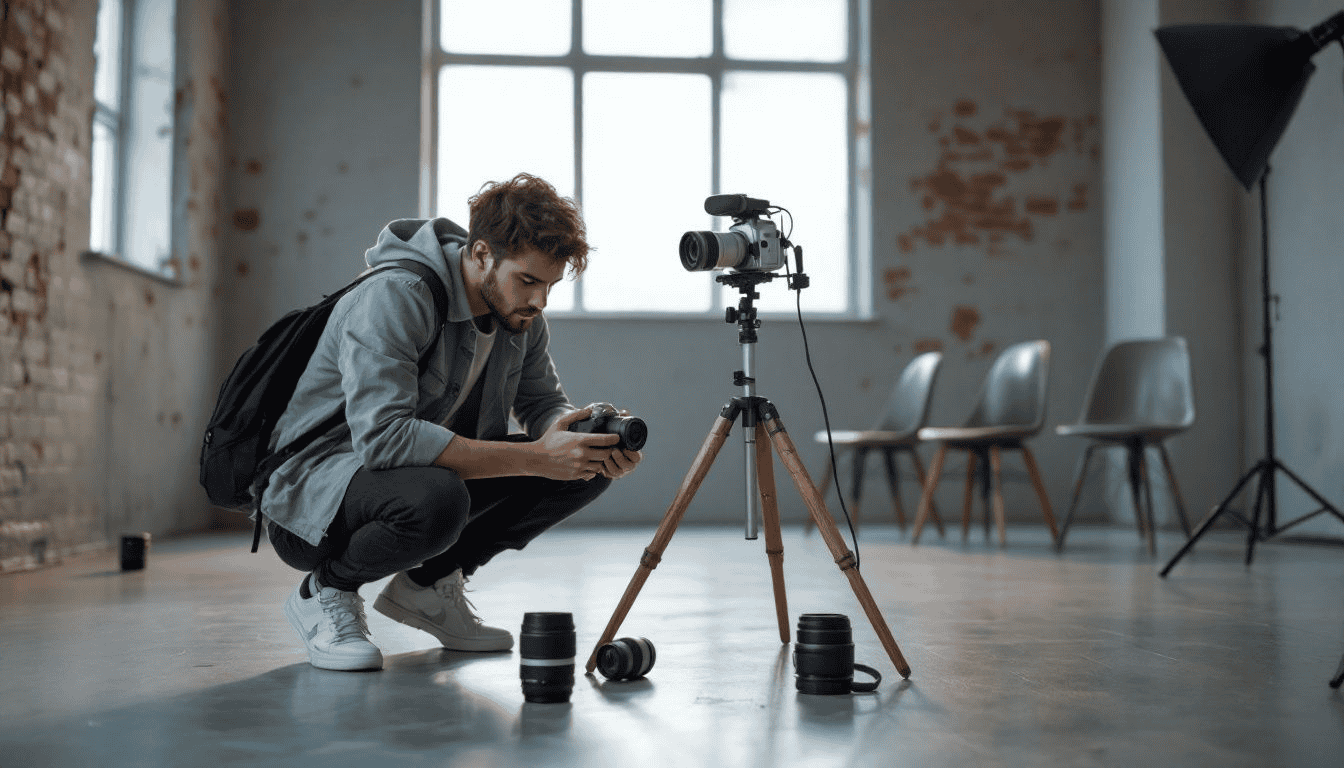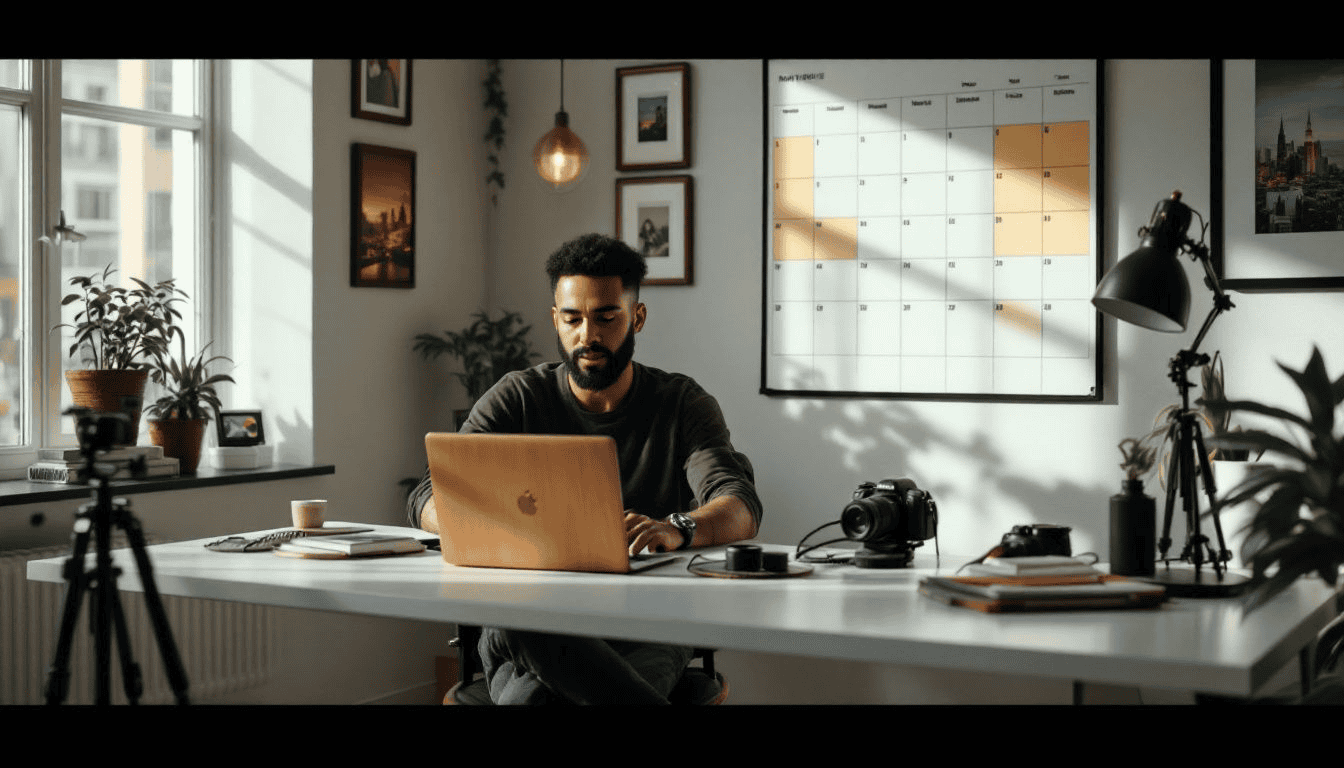The Ultimate Guide to Freelance Photography in Retirement: Tips and Strategies for Success

Want to turn your passion for photography into a flexible freelance career in retirement? Freelance photography offers you the freedom to set your own schedule, stay creative, and make extra income. In this guide, we’ll show you why freelance photography is ideal for retirees and how to get started, find clients, and succeed.
Key Takeaways
Freelance photography offers retirees flexibility, creative expression, and a chance to earn income while maintaining personal balance.
Success in freelance photography requires choosing a niche, building skills, creating a portfolio, and marketing yourself effectively.
Networking, leveraging personal connections, and consistently improving skills are essential for finding clients and staying inspired in your photography journey.
Why Photography Side Hustles Are Perfect for Retirees

As a freelance photographer you can work at your own pace and schedule, perfect for post retirement. Unlike traditional jobs you can choose when and where you work and balance your new career with your personal life.
And freelance photography combines creativity with income. Retirees can use their artistic talents to create amazing images, whether real estate, wedding or product photography. This is a creative outlet that keeps you active and engaged in meaningful work.
And it’s low physical strain compared to other side hustles. So it’s open to most retirees regardless of physical condition. With the right skills and equipment retirees can have a fun and profitable hobby without physical limitations.
How to Start Your Freelance Photography Business

The first step in starting your small business freelance photography business is choosing your niche. Whether you’re interested in portraits, events, real estate photography, nature, or stock photography, picking a niche helps you focus your efforts and develop specialized skills. For instance, if you enjoy capturing the beauty of homes, real estate photography might be your calling.
Once you’ve chosen your niche, it’s time to invest in essential equipment. A good camera, versatile lenses, sturdy tripods, and reliable editing software are crucial for producing high-quality images. Don’t forget to consider accessories like camera bags and memory cards to ensure you’re always prepared for a shoot.
Building basic photography skills is also essential. Leverage online courses and free tutorials to learn the ins and outs of your chosen niche. Whether it’s mastering the art of food photography or honing your skills as a wedding photographer, continuous learning is key to success.
Creating a photography portfolio is another critical step. Assemble an impressive showcase of your work to attract potential clients. Your portfolio should highlight your best photos and demonstrate your versatility as a professional photography service. Consider including high-quality images from different types of shoots, such as weddings, real estate, and product photography.
Finally, start taking photos and experimenting with different styles and techniques. Practice makes perfect, and the more you shoot, the better you’ll become. Join photography clubs or forums to exchange tips and get feedback from fellow photographers. This will help you refine your skills and stay motivated.
What is Freelance Photography?
Freelance photography is a fun and flexible career where you work for yourself, choose your own projects and clients. Unlike employment you have the freedom to work as much or as little as you like making it perfect for retirees. This self employed model allows you to work in many different fields such as sports, weddings, fashion, wildlife, real estate and food photography.
The beauty of freelance photography is the diversity. Whether you love capturing the detail of a delicious meal in food photography or the grandeur of architectural masterpieces in real estate photography, there’s a niche for everyone. This career allows you to follow your passion and have a rewarding and profitable business. By working for yourself you can tailor your projects to your interests and expertise and have a fulfilling and enjoyable retirement.
Setting Up Your Business
Starting a freelance photography business takes planning and execution to be successful in the long run. Here are the basics to get you going:
Define Your Niche: What type of photography do you want to do? Portrait, event or product? Focusing on a niche helps you develop skills and attract clients.
Create a Business Plan: A business plan that outlines your goals, target market, pricing and marketing strategy. A good plan is your roadmap.
Register Your Business: Register your business with the relevant authorities and get any necessary licenses and permits. This step makes your business legal and professional photography service.
Build a Website: A professional website to showcase your work, services and contact info. A good website is your online portfolio and attracts potential clients.
Establish Social Media: Create social media accounts to promote your work, engage with potential clients and build your brand. Instagram and Facebook are great for photography.
Buy Equipment: Invest in good camera equipment, lighting and editing software so you can deliver great images. Good equipment is key to professional results.
Create a Contract: A contract that outlines the terms and conditions of your services, payment terms, copyright and usage rights. A clear contract protects you and your clients.
Now you’re ready to go!
Marketing Yourself as a Self-Employed Photographer

Marketing is a crucial aspect of any freelance photography business. Start by building an online presence through social media and a personal website. Platforms like Instagram, Facebook, and a professional website can showcase your portfolio, making it easier for potential clients to find and hire you.
Networking is another powerful tool. Connect with local businesses, event planners, and community groups to spread the word about your photography services. Attend events and introduce yourself as a freelance photographer to build a network of contacts who might need your services or refer you to others.
Leveraging online platforms can also help you reach a broader audience. Sell images as stock photos or list your professional photography services on marketplaces like Fiverr or Upwork. This not only increases your visibility but also provides additional income streams, making money.
Don’t underestimate the power of word-of-mouth marketing. Encourage satisfied clients to refer you to their friends and family. Happy clients are often your best advocates, and their recommendations can lead to more clients and prospective clients.
Finally, always carry a business card with you. You never know when you’ll meet someone interested in your photography services. A professional business card can leave a lasting impression and make it easy for potential clients to contact you.
Finding Clients for Your Photography Side Hustle
Finding clients is one of the biggest challenges for freelance photography, but there are several strategies you can use. Start by attending local networking events and offering your photography services. Events like community fairs, school functions, and local markets provide excellent opportunities to showcase your skills and attract potential clients.
Partnering with senior centers, schools, or local businesses can also help you find clients. These organizations often need photography services for their events and activities. Offering your services helps build relationships and establish a steady stream of clients.
Don’t hesitate to use your personal network. Family and friends can be valuable resources for spreading the word about your freelance photography business. They can recommend you to their contacts and help you reach a wider audience.
Joining photography groups is another great way to find clients. These groups allow you to connect with fellow photographers, exchange tips, and get referrals. Being part of a community can provide support and open doors to new opportunities.
Managing the Business Side of Independent Photography Work

Having a business plan is key to the business side of freelance photography and success. Start by knowing market rates and set your prices competitive. Research what other freelance photographers charge and adjust your pricing to attract clients and be profitable.
Taxes and paperwork is another big one. As a retired freelance photographer you’ll need to know about self employment taxes and keep track of your income and expenses. Consider consulting with a tax pro to make sure you’re in compliance and not surprised.
Time management is key to balancing photography side hustle with personal life. Create a schedule that allows you to take photos, edit and market while still enjoying your retirement. Being organized and prioritizing helps you stay on track.
Dealing with clients professionally is important for a good reputation. Set clear expectations from the start, communicate well and deliver quality work on time. Happy clients come back and refer you to others and that’s how you build a successful freelance photography business.
And finally invest in marketing materials like a business card and a portfolio. These will leave an impression on potential clients and show off your work. Always be ready to self promote yourself and your services whenever you can.
Pricing Your Services
Pricing yourself as a self-employed photographer can be tough but you got to get it right to have a profitable career and attract clients. Here are some tips to help you price yourself:
Research the Market: Research the market to see what other freelance photographers are charging in your area. Knowing what others are charging helps you set your rates.
Calculate Your Costs: Calculate your costs, equipment, software, travel etc. Knowing your costs means your pricing covers your costs and gives you a profit.
Who’s Your Target Market: Who’s your target market and what level of service do they need. Pricing yourself to your target market helps you attract the right clients.
Price Structure: Price structure, hourly rates, package deals, discounts. Offering different price options appeals to a wider range of clients.
Experience: Experience and level of expertise. More experienced photographers can charge more.
Negotiable: Be willing to negotiate with clients. Flexibility gets you more clients and builds long term relationships.
By following these you can price yourself fairly and attract clients.
Creating a Schedule and Workflow
Making a schedule and workflow is key to managing your time and delivering professional photography services to your clients. Here are some tips to help you make a productive schedule and workflow:
Plan Your Day: Plan your day, including your shoot, edit and admin tasks. Having a plan helps you stay on track.
Prioritize Your Tasks: Prioritize your tasks, do the most important and urgent first. Prioritization helps you meet deadlines and deliver good work.
Use a Calendar: Use a calendar to schedule your shoots, meetings and deadlines. A calendar helps you keep track of your commitments and manage your time.
Set Deadlines: Set deadlines for yourself and your clients so you can deliver images on time. Clear deadlines helps you stay on track and meet client expectations.
Use Project Management Tools: Use project management tools like Trello or Asana to manage your workflow and collaborate with clients. These tools help you stay organized and streamline your processes.
Review and Update: Review and update your schedule and workflow regularly so it’s working for you. Review helps you find areas to improve and make changes.
By doing this you’ll have a smooth workflow and deliver good images and manage your time.
Staying Inspired and Growing as a Freelance Photographer
To stay inspired and keep improving your photography for the long haul, get involved in workshops, contests or exhibitions to challenge yourself and get noticed. These are opportunities to show your work and get feedback from the pros.
Try new styles and techniques regularly to keep your work fresh and exciting. Try food photography or fashion photography to add to your skillset and find new passions.
Join online photography forums too to stay motivated. These are a great source of feedback, ideas and support from other photographers. Engage with others who share your passion and you’ll be inspired and grow as a photographer.
Travel and find new subjects to photograph too. Go new places, meet new people and shoot what’s around you. The world is full of inspiration waiting to be shot.
Staying Current with Industry Trends
Keeping up with industry trends is crucial to staying competitive and relevant as a freelance photographer. Here are some practical ways to stay informed:
Attend Workshops and Conferences
Participate in workshops and conferences to learn about the latest photography techniques, cutting-edge equipment, and current industry trends. These events are great for both education and networking.Follow Industry Leaders
Stay connected with industry leaders and influencers on social media to keep up with news and emerging trends. Watching their work and insights can be a constant source of inspiration.Read Industry Publications
Dive into photography magazines, blogs, and online resources to stay informed about advancements in the field. Regular reading helps you discover new techniques and ideas.Join Online Communities
Become part of online photography forums and groups. Engaging with fellow photographers fosters connection, support, and fresh perspectives on trends.Experiment with New Techniques
Don’t be afraid to try new techniques or experiment with the latest equipment. It’s a great way to keep your portfolio fresh and ahead of the curve.Commit to Lifelong Learning
Continuously invest in your education by exploring new photography software, tools, and methods. Staying curious and open to learning ensures your skills remain sharp and competitive.
By staying informed and adaptable, you’ll maintain an edge in the fast-evolving photography industry and continue to thrive as a freelancer.
Summary
In short, freelance photography has flexibility, creativity and income. Choose a niche, invest in the right equipment and build a portfolio and you’ll be set. Marketing yourself, finding clients and the business side are key to a successful freelance photography business.
Stay inspired by trying new things, entering contests and connecting with other photographers. With commitment and passion you can turn your love of photography into a career that adds to your retirement.
FAQs
How do I choose a photography niche?
Choose a photography niche by exploring your interests and strengths. Try out different styles like portraits or events to see what really gets you going!
What do I need to get started as a freelance photographer?
To get started as a freelance photographer make sure you have a good camera, versatile lenses, a tripod and editing software. Don’t forget camera bags and memory cards to keep you ready and organised!
How do I market myself as a freelance photographer?
To market yourself as a freelance photographer focus on creating an online presence with a personal website and active social media profiles. Network locally and use Fiverr to get more exposure and encourage happy clients to spread the word about your work.
How do I find clients as a retired photographer?
To find clients as a retired photographer use your personal network, attend local events and collaborate with senior centers and local businesses. Get involved in photography groups and you’ll get more exposure and connect with potential clients!
How do I stay inspired and try new things?
Enter contests, try new styles and join online photography groups. Trying different subjects will improve your skills and get you fired up to capture more!
Disclosure: Some of the links in this article may be affiliate links, which can provide compensation to us at no cost to you if you decide to purchase. This site is not intended to provide financial advice. You can read our affiliate disclosure in our privacy policy.
